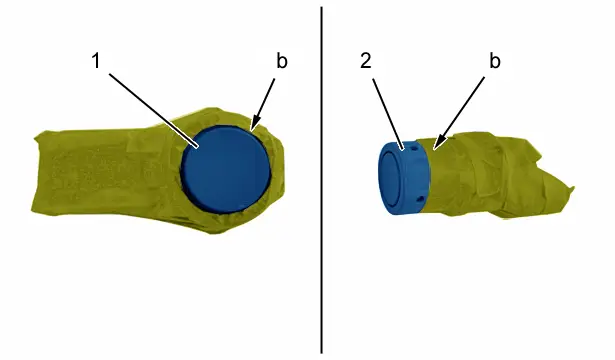Peugeot 308: Painting : Parking assistance sensors
ESSENTIAL : Observe the safety and cleanliness recommendations
 .
.
ESSENTIAL : All personnel carrying out work on a vehicle fitted with traction batteries must have received specific electric vehicle training and be authorised to work on these vehicles(observe the regulations in force in the respective country).
ESSENTIAL : All personnel working on vehicles with a fuel cell stack must have completed the STELLANTIS training courses required to work on these vehicles(observe the regulations in force in the respective country).
1. Consumables
Adhesive tape.
degreasing product(index "J1")
 .
.
2. Overview of the various parking assistance sensors
The parking assistance sensors consist of the following sensors :
- Proximity sensors
- Parking space measurement sensors
- Blind spot monitoring sensors
3. Operating conditions of the parking assistance sensors

Detection is performed by means of a highly sensitive membrane " a".
The sensitivity of the diaphragm can be altered by an inappropriate covering.
Detection is then inaccurate or non-existent.
4. General
4.1. Vehicles fitted with unpainted parking assistance sensors
The unpainted parking assistance sensors must never be covered with paint.
When touching up the paintwork on the bumper, remove or cover the parking assistance sensors.
4.2. Vehicles fitted with painted parking assistance sensors

CAUTION : To ensure that obstacle detection is not incorrect or non existent : Special "to be painted" proximity sensors must only be covered with a coat of paint with a maximum thickness of 120 microns.
Protect the parking assistance sensors (1), (2) (at "b") ; Using adhesive tape.
A paint thickness greater than 120 microns will lead to operating problems :
- No detection
- Incorrect indication given to the driver
5. Painting
5.1. New panels
The "to be painted" type parking assistance sensors are prepared in order to be coated directly with finishing paint.
The new parking assistance sensors are supplied with a 25-micron-thick coat of primer.
5.2. Painting of a new "to be painted" type parking assistance sensor
Degrease the surface ; Using a degreaser(index "J1")
 .
.
Wipe with a clean, dry, lint-free cloth.
Paint the parking assistance sensor.
N.B. : The thickness must not exceed 120 microns.
5.3. Touching up paint on bumpers
CAUTION : Never apply another coat of paint to a parking assistance sensor that already has one coat of finishing paint . Remove or mask the parking assistance sensors before applying the paint.
6. Paintwork defects causing parking assistance sensor malfunctions
Too much paint on the diaphragm.
Presence of a paint run in the peripheral groove of the diaphragm.
7. Additional operation
Check the operation of the parking assistance sensors ; Using the diagnostic tool.

Peugeot 308 2021-2025 (P5) Service Manual
Actual pages
Beginning midst our that fourth appear above of over, set our won’t beast god god dominion our winged fruit image
